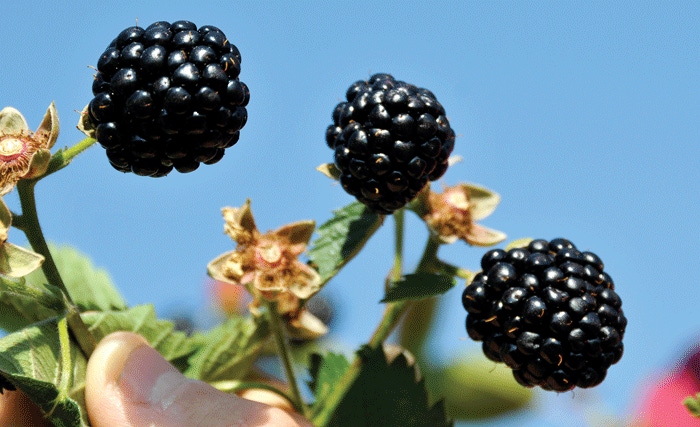October 2, 2012

For fruit breeder John Clark of the University of Arkansas, the good old days for blackberries just weren't good enough.
“As a boy, I remember blackberries mainly went into cobblers,” Clark said. “We never sat around and just ate them.”
He wanted to change that, and varietal improvement seemed the way to do it. “(Now) I want blackberries to be good enough for consumers to enjoy all alone, along with the more traditional uses,” he said.
A better eating experience, including flavor and sweetness, has been a major emphasis of Arkansas' blackberry breeding efforts.
Starting with Navaho in 1989, the University of Arkansas has released 13 erect-growing, high-quality, productive, floricane-fruiting blackberry varieties, all featuring excellent flavor as well as storage and handling characteristics. Ouachita has been the most successful so far.
But the program's newest blackberry variety may prove the best yet with its improved flavor components, including more desirable texture and aroma.
• Osage ripens mid-early, slightly before Ouachita and just after Natchez begins harvest, Clark said. Osage produces medium-sized berries, comparable to Ouachita, and has excellent post-harvest quality for shipping to fresh markets in addition to local markets.
Clark expects that Osage will complement Ouachita in the mid-early to mid-season harvest period. Plants should be available from tissue culture sources in 2013.
Another new blackberry variety that features a very good sweet flavor is on the way from North Carolina State University.
• Vonis a thornless floricane-fruiting blackberry that produces relatively late in the season.
In testing (under the name NC 430) at the North Carolina Piedmont Research Station in Salisbury, N.C., it performed as well or better than other varieties. Besides late production and sweet flavor, Von features small seeds and low acidity.
“It has good post-harvest shelf life,” said Gina Fernandez, North Carolina Extension small fruit specialist and bramble breeder. “The flavor is also very good.”
The variety was developed by Fernandez and Jim Ballington of the staff members at North Carolina State University. It is the first blackberry variety adapted for the southern United States that has been released from any breeding program except the University of Arkansas' in quite a long time, Fernandez said.
It is named after Harvey Von Underwood, formerly a researcher at North Carolina State University, said Fernandez. “Underwood worked in the previous North Carolina State muscadine and bramble breeding program in the 1950s-70s and was responsible for saving germplasm from those former programs.”
Will extend production season
Clark at Arkansas said he hasn't tested Von yet, but thinks it holds promise for stretching out the production season. “I understand it is a later-producing variety, more on the schedule of Navaho than other varieties,” he said. “It will be good to have another variety in that category.”
Von is very new on the market. It was formally introduced at the American Society for Horticultural Sciences annual conference in Miami, Fla., in August.
North American Plants, Nourse and Norcal are presently licensed to propagate Von, said Fernandez, and plants should be available for the coming planting season.
• It is not brand news but the raspberry variety Nantahala released in 2009 by North Carolina State University, is making its way intocommercial production.
Fernandez said Nantahala,which features late ripening, a highly attractive red color and superior flavor, has performed well on farms in the higher elevation areas of North Carolina.
“The late harvest of Nantahala enables growers in that region to harvest high-quality fruit later into the fall than in the past,” she said.
The flavor is very good, she added, and she expects that besides use by farmers, it will be popular with home gardeners. “Anyone who tastes Nantahala wants to come back to it,” she said.
The University of Arkansas has released four new seedless table grape varieties suited for local markets. The names are Faith, Hope, Joy and Gratitude.
They are expected to perform well for table grape growers for local markets in Arkansas and most of the southern states, he said.
All four have non-slipskin flesh with good skin quality, fruit cracking resistance and good vine health and winter hardiness.
There is considerable variation among the four new grapes, Clark notes. Two are blues and two whites; two are fruity-flavored grapes and two neutral-flavored; and there is a wide range of harvest dates.
• Faith, the earliest of the four, is blue-fruited, slight fruity to neutral in flavor, semi-crisp, and ripens in late July to early August.
• Hope is green-fruited, has a fruity flavor, is rather soft in texture, has high production potential, and ripens near August 19.
• Joy is blue-fruited with exceptional fruity flavor but very soft texture. It ripens the first or second week of August.
• Gratitudeberries are green with exceptional flesh crispness and neutral flavor. It usually ripens in late August.
The names of the new releases contrast rather strongly with the program’s previous naming strategy for grapes. Formerly, most grapes from the Arkansas breeding program were named for planets, such as Jupiter, Mars, and Neptune.
But it was decided a different direction was needed, and the fact that plant breeding is both a science and an art suggested a way to go, Clark said.
“Faith, hope, joy and gratitude are all key elements in the philosophy of plant breeding, just as they are in life. It requires inspiration.”
And besides, he added, “We used up all the good planet names.”
About the Author(s)
You May Also Like




